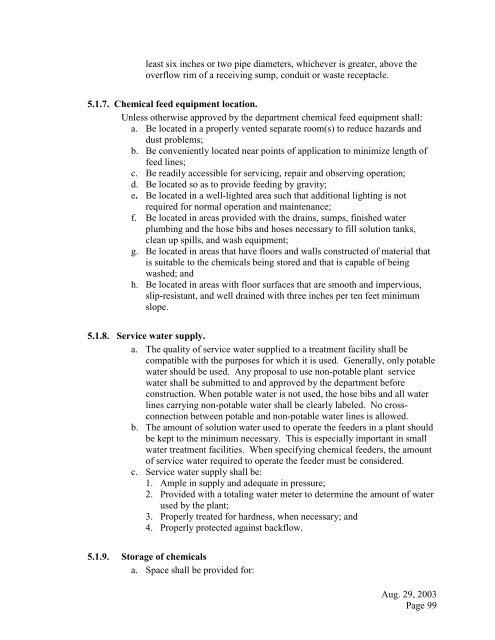Design Guide for Community Water Systems - The Water, Sanitation ...
Design Guide for Community Water Systems - The Water, Sanitation ...
Design Guide for Community Water Systems - The Water, Sanitation ...
You also want an ePaper? Increase the reach of your titles
YUMPU automatically turns print PDFs into web optimized ePapers that Google loves.
least six inches or two pipe diameters, whichever is greater, above theoverflow rim of a receiving sump, conduit or waste receptacle.5.1.7. Chemical feed equipment location.Unless otherwise approved by the department chemical feed equipment shall:a. Be located in a properly vented separate room(s) to reduce hazards anddust problems;b. Be conveniently located near points of application to minimize length offeed lines;c. Be readily accessible <strong>for</strong> servicing, repair and observing operation;d. Be located so as to provide feeding by gravity;e. Be located in a well-lighted area such that additional lighting is notrequired <strong>for</strong> normal operation and maintenance;f. Be located in areas provided with the drains, sumps, finished waterplumbing and the hose bibs and hoses necessary to fill solution tanks,clean up spills, and wash equipment;g. Be located in areas that have floors and walls constructed of material thatis suitable to the chemicals being stored and that is capable of beingwashed; andh. Be located in areas with floor surfaces that are smooth and impervious,slip-resistant, and well drained with three inches per ten feet minimumslope.5.1.8. Service water supply.a. <strong>The</strong> quality of service water supplied to a treatment facility shall becompatible with the purposes <strong>for</strong> which it is used. Generally, only potablewater should be used. Any proposal to use non-potable plant servicewater shall be submitted to and approved by the department be<strong>for</strong>econstruction. When potable water is not used, the hose bibs and all waterlines carrying non-potable water shall be clearly labeled. No crossconnectionbetween potable and non-potable water lines is allowed.b. <strong>The</strong> amount of solution water used to operate the feeders in a plant shouldbe kept to the minimum necessary. This is especially important in smallwater treatment facilities. When specifying chemical feeders, the amountof service water required to operate the feeder must be considered.c. Service water supply shall be:1. Ample in supply and adequate in pressure;2. Provided with a totaling water meter to determine the amount of waterused by the plant;3. Properly treated <strong>for</strong> hardness, when necessary; and4. Properly protected against backflow.5.1.9. Storage of chemicalsa. Space shall be provided <strong>for</strong>:Aug. 29, 2003Page 99
















